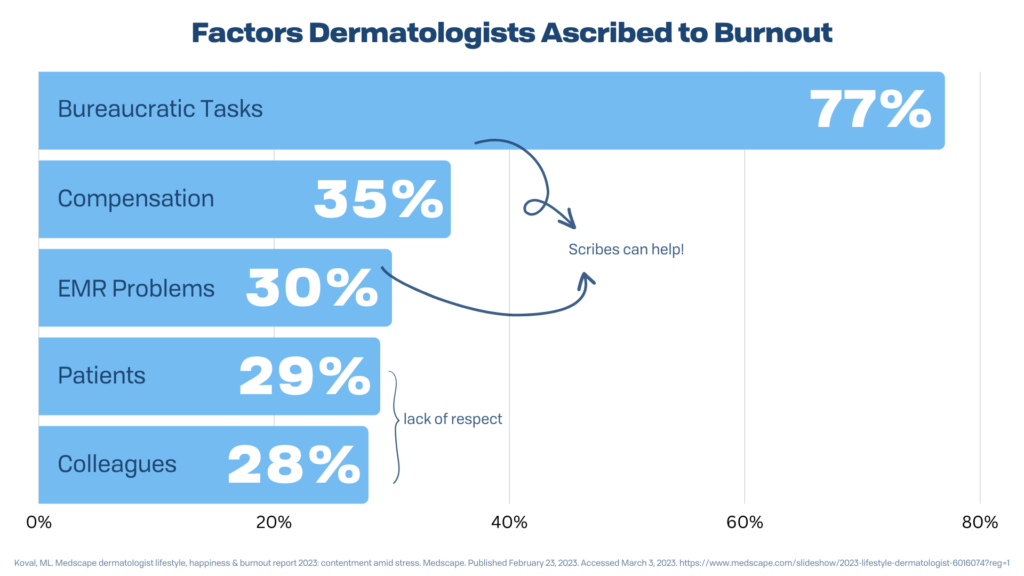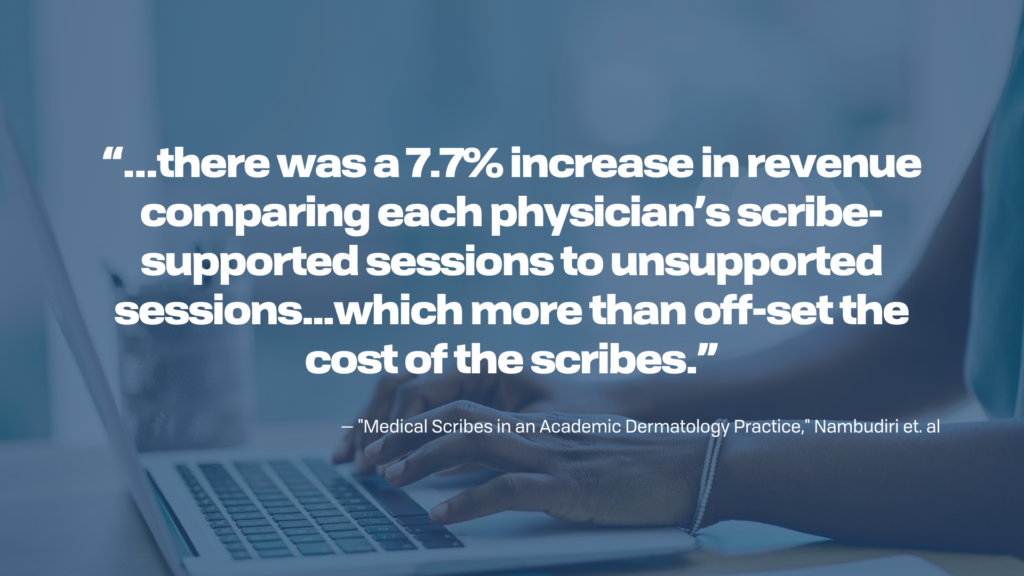Struggling to thrive
Provider burnout continues to worsen post-pandemic, and every corner of healthcare has been impacted. Despite ranking among the “happiest” of specialties, dermatologists are experiencing increasing levels of dissatisfaction. Schlesinger reports that while dermatologists previously polled at an 85% happiness rate, that number has fallen to 62% as of October 2022 (Burnout and the Dermatologist). A November report from the University of Pennsylvania, Perelman School of Medicine, confirmed that not only is burnout on the rise amongst dermatologists, but they’re experiencing the increase at a higher rate than other specialties (Nelson et. al).
Burnout itself is nebulous. It is described as exhaustion, depression, loss of focus, apathy, frustration, and more. The condition also requires the sufferer to admit that they’re experiencing symptoms. Refusal or failure to self-identify may lead to incorrect reporting on the incidents of burnout. This phenomenon appeared in the 2022 study, “A mixed methods study on factors that promote and ameliorate burnout in academic dermatologists.” Researchers commented that some participants acknowledged experiencing symptoms of burnout while denying that they were sufferers. “Some described the conditions or sensations of burnout, but remained adamant that they did not experience burnout.” With this evidence of underreporting, burnout is likely even more widespread than current numbers reflect.
Contributing factors
Several factors contribute to burnout across the industry, but among the highest ranked are bureaucratic or administrative tasks, compensation, and struggles with EMRs. Belabored with integrations, requirements surrounding PHI, and inconsistencies between platforms, EMRs have been a point of stress for many care teams, taking away their focus on patients.

Providers struggle to keep their focus on patients as documentation, administrative workflows, and EMRs demand more and more of their time. While record keeping is important, it also distracts from the real work at hand, which requires human connection and singular focus. This is especially true for dermatology, a specialty where the bulk of information comes from a provider looking at a patient, not asking questions while filling out records.
The Dermatology Times reported that providers spend an average of 4.5 hours a day working in EMR systems. And EMR usage is higher than in other countries, which typically spend only an hour a day submitting electronic notes.
How scribes can help
While medical scribes have always been a part of care teams, their use has skyrocketed. Reports and studies continue to show that the addition of medical scribes decreases provider burnout, increases patient satisfaction, and can save practitioners money. Scribes are an investment that pays for itself.

A team from Harvard Medical School published their study titled “Medical Scribes in an Academic Dermatology Practice” detailing the impact of scribes on efficiency, earnings, and burnout. The study found that the use of scribes increased revenue by 7.7%, not only covering the investment in scribes but resulting in higher revenue overall. 79% of physicians in the study felt that they could comfortably increase their patient volume with scribe support.
Published in Dermatology Today, the study titled “Impact of medical scribes on dermatology trainee and attending experience” found that with scribe assistance an average of 1-2 additional patients were scheduled per half-day clinic. The majority of attendings and trainees reported that medical scribes helped to decrease documentation time, increased time for attendings and trainees to work together, and improved overall education of the practice. The deployment of scribes not only reduces burnout and increases revenue, but encourages and allows providers to practice top-of-license, freeing them to develop better relationships across their team and improve outcomes for their practice.
ScribeAmerica provides the best-trained scribes in the industry, with in-person, audio, video, and AI solutions. Wherever and however you work, expert medical scribes are available to ease your burden and help provide better outcomes for both providers and patients.
Interested in reducing burnout in your practice? Connect with us to learn more.
References
Gordon, Deb. “Amid Healthcare’s Great Resignation, Burned out Workers Are Pursuing Flexibility and Passion.” Forbes, 12 Oct. 2022, www.forbes.com/sites/debgordon/2022/05/17/amid-healthcares-great-resignation-burned-out-workers-are-pursuing-flexibility-and-passion/?sh=43219d047fda.
Nambudiri, Vinod E, et al. “Medical Scribes in an Academic Dermatology Practice.” JAMA Dermatology, 1 Jan. 2018, www.ncbi.nlm.nih.gov/pmc/articles/PMC5833578/.
Nelson, Maria N., et al. “A Mixed Methods Study on Factors That Promote and Ameliorate Burnout in Academic Dermatologists – Archives of Dermatological Research.” SpringerLink, 9 Nov. 2022, link.springer.com/article/10.1007/s00403-022-02441-0.
Payerchin, Richard. “Physicians Spend 4.5 Hours a Day on Electronic Health Records.” Dermatology Times, 22 Apr. 2022, www.dermatologytimes.com/view/physicians-spend-4-5-hours-a-day-on-electronic-health-records.
Schlessinger, Joel. “Burnout and the Dermatologist.” Practical Dermatology, practicaldermatology.com/articles/2023-mar/burnout-and-the-dermatologist. Accessed 28 June 2023.Zhong, Connie S, et al. “Impact of Medical Scribes on Dermatology Trainee and Attending Experience.” Dermatology Online Journal, 7 Nov. 2019, escholarship.org/uc/item/1xc5n4t2.



